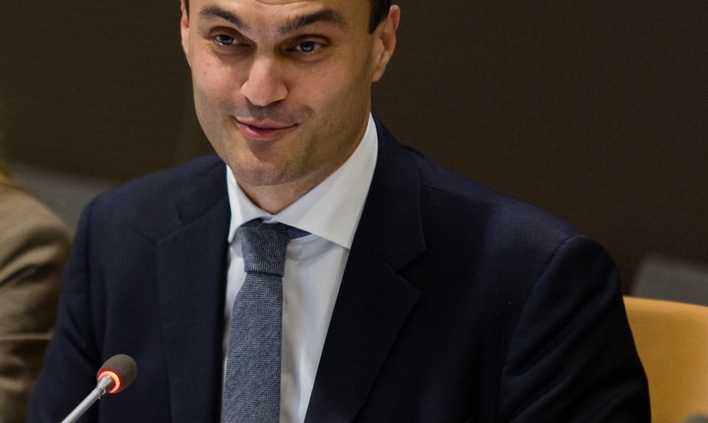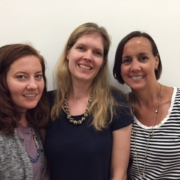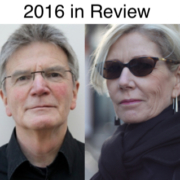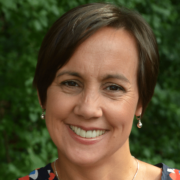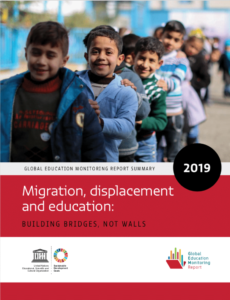 Today we bring you a special episode of FreshEd. With me is Manos Antoninis, the Director of the Global Education Monitoring Report, which was just released.
Today we bring you a special episode of FreshEd. With me is Manos Antoninis, the Director of the Global Education Monitoring Report, which was just released.
Each year, UNESCO publishes an editorially-independent Global Education Monitoring Report to monitor the progress towards the education targets in the Sustainable Development Goals. This year’s topic is migration, displacement, and education.
Based on evidence from around the world, the report argues that investing in the education of mobile people can actually create cohesion and peace. Of course, there are many challenges facing children, teachers, policymakers, and society from the displacement and migration of large numbers of people.
The 2019 report is entitled Migration, Displacement, and Education: Building Bridges, not Walls and is available online now.
Citation: Antoninis, Manos, interview with Will Brehm, FreshEd, 136, podcast audio, November 20, 2018. https://www.freshedpodcast.com/antoninis/
Transcript, Translation, and Resources:
Will Brehm 0:53
Manos Antoninis, welcome to FreshEd.
Manos Antoninis 1:31
Thank you for having me with you.
Will Brehm 1:32
So, congratulations on the new Global Education Monitoring Report that released today. So, the main focus of this new report is on migration, displacement and education. How was this topic decided?
Manos Antoninis 1:45
The report is an editorially independent output, hosted and published by UNESCO. And we have an advisory board that convenes once a year and we propose to the board three themes that have been collectively discussed inside the team that we believe are important, and also responds to the mandate of the report, which is to monitor, of course, education in the Sustainable Development Goals, but also to respond to key challenges and strategies that have been identified in the roadmap for achieving SDG 4. That’s a document called the Framework for Action. So, based on the Framework for Action, we proposed three themes to the board and the board then discusses. It’s a very open and really insightful discussion about their ideas, their perceptions of what is really going to be the most relevant topic in two year’s time -because usually the choice happens two, now even more than two years in advance. So clearly, migration, displacement at the time of the choice was at the top of the news agenda. Primarily as a result, of course, of the Syrian crisis and its aftermath in the Middle East, but also in Europe. And, of course, the ongoing arrival of migrants -often undocumented- across the Mediterranean. But I think we will not have selected this topic just on the basis of that regional interest. Our report is global and therefore, the focus of it has to be a topic of global significance. And we believe migration, displacement is such an issue.
Will Brehm 3:32
So, what is the scale of this global issues of migration and displacement today?
Manos Antoninis 3:38
That’s an interesting question. There is a lot of debates about -not so much the volume, but- how important it is today compared to other times in history. It is perhaps a cliché, but it’s true that human beings are very mobile, and that’s how they populated the planet. And that’s how they ended up making all sorts of advances. There is a feeling that migration in recent years has increased. And it’s true that since 1990, when the United Nations Population Division started compiling migration data on a more systematic basis, there has been an increase from about 2.8% of the global population to 3.4%, the latest estimate in 2017. But some earlier evidence going back to the 1960s, which the World Bank published earlier this year, shows that actually, even in the mid 1960s, the rate of migration was also above 3%. So, it’s only a small increase that is part of the normal fluctuation that happens from year to year. But just to give a little bit of a sense of the volume. So, we’re talking about 257 million international migrants. That means, according to the definition of the UN, nationals of other countries living in another country. In addition to those, which is about one in 30 people, let’s say in the world, the report also talks about the one in 80 people who are displaced. Some of them are displaced internally, others are displaced across the border, seeking refuge from persecution, conflict, and applying for asylum and some of them getting refugee status. There are about 25 million refugees in the world today. And that’s considered to be the highest number since World War Two. In addition, we know that there are about 3 million asylum seekers, 40 million people who are internally displaced. And the report also makes reference to the 19 million people who are displaced, not for conflict but as a result of a natural disaster. Maybe I should close by saying that in addition to those, the report does not only talk about international migration, international migrants and refugees, but also about internal migration and estimates on these are quite difficult to get but one that we favor in the report is that one in eight people are actually living in a province or a region of the country different to the one that they were born. And that means primarily, but not exclusively, people moving from villages to cities. But there is also another dimension that makes the report particularly fascinating as a mobility and that is the mobility of people inside borders or across borders that is cyclical. People who migrate for livelihood. Nomads and pastoralists for example, that adds another dimension to the very complex nature of human mobility.
Will Brehm 6:52
It’s incredibly complex, it sounds like. And I guess one of the issues that I sometimes have difficulty with is keeping track of the differences between the idea of what a refugee is versus what an asylum seeker is versus a displaced person. Could you sort of clarify some of these terms that are being used to talk about the mobility of people?
Manos Antoninis 7:15
Yes, you’re absolutely right. This is quite a complex field, and also one field that many feel particularly strong about. We provide glossaries in the reports that give the official definitions. I could go into some detail explaining that, but I think the most important thing is to remember that this report is not a report about migration and displacement, per se. It’s a report about the mutual interactions between migration, displacement, and such demographic phenomena AND education. And I think that’s the message that this report is trying to bring that is very important. That we would like to see this phenomena from the point of view of teachers, the point of view of education planners and administrators who have to deal with children in the classroom regardless of the precise definition of their status. Because a teacher does not necessarily need to care. Sometimes they need to care because there are, of course, children of undocumented migrants that are threatened with deportation. Or there are children that have particular exposure to trauma because of having fled some conflict. But they are not interested so much in the precise definition. They’re more interested about understanding the challenges that these children have. But also, the challenges of the host communities that need to accommodate them. And that is a key message of the report.
Will Brehm 8:40
So, what are some of these challenges? I mean, for these children that are moving across borders, and entering societies and communities that are completely foreign to them and eventually entering into some sort of education system -What are some of these challenges that the report documents?
Manos Antoninis 8:58
I think you rightly mentioned in your question, entering the national education system is a major challenge. And the report highlights the very important progress that has been achieved in recent years in countries understanding, realizing, and taking on the responsibility in the case of particularly displaced people, the refugees who have crossed the border that these people need to be integrated into the national education system as soon as possible. There was a tendency in previous years -for, let’s say, out of inability to decide what is best- to tend to group refugee children in schools in the camps where they originally settled. But we realized that many of these crises are actually protracted, that family’s cross borders in principle for a short time -but this time gets extended. And then the children of refugees who are not able to enter the national education system, then end up being excluded of the possibility of further advancing their education, having employment opportunities and integrating in the societies that hosted them. So, the fact that in recent years, as a combination of a number of factors, host countries have faced this head on and have opened the doors of their schools and their education institutions to refugee children is a major advance and a positive message that we’re definitely portraying. But as you said, there are a number of obstacles that need to be overcome. These obstacles are particularly strong when the language of the refugee children and more broadly, of course, the immigrant children is different to that of the language of instruction, and the community language in the area where they settle. And of course, many countries have responded by offering preparatory courses to help these children make the transition to the new environment. But the report makes a particularly strong case that such preparatory periods should not be too long because it’s not just a technical matter of learning the language, it’s also the case that children need to interact with their peers. So, the longer they are separated in a separate class being helped to advance and integrate more smoothly into the class, then the more problematic this becomes overtime.
Will Brehm 11:29
Is it common for children of families who crossed borders to be accepted into national education systems? Or is that more of something that’s less common when we look at the types of education available for refugee children or asylum-seeker children? I would imagine it’s different depending on exactly who we’re talking about.
Manos Antoninis 11:51
Yes, indeed. The asylum-seeking children that end up in detention centers in many parts of the world, from Australia to Indonesia, from Hungary to Mexico, often do not have the education opportunities that they are entitled to. And that’s a particular category that the report draws attention to. But you raise a very interesting question on the receptiveness of the communities. There are cases, even when the government proposes that the refugee children should be included in the national education system, there are cases of communities that react saying that they don’t want their children to be interacting to be mixed with other children that have different needs. And in that case, the political will of governments and local authorities and schools to take a stance has been very, very important. But there are also other ways -and that’s another dimension that the report is drawing attention to- where immigrants in particular, and refugees, end up settling in communities that are quite isolated. There’s an extreme example in Kenya, the influx of refugees from Somalia or from South Sudan in quite remote parts of the country mean that these children do not have the opportunity to meet let’s say the local community because they settle in a very remote area, so they are forced to go to school in camp areas, even though these schools follow the national curriculum. Another extreme example is the cases of Lebanon and Jordan, where the amount of refugees is so high compared to the population, the highest rate in the world, that the countries themselves cannot afford to build such a large number of new schools. So inevitably, they have come up with solutions of two shifts, which means again, lower probability to interact with the children in the host community. But the more extreme version -a more sophisticated version- of such differentiation is the immigrant communities in high income countries where immigrants tend to settle in poorer neighborhoods and families of host communities often tried to avoid such schools with large concentrations of immigrant populations and find all sorts of mechanisms -both the parents and the schools themselves- to create space for children from the host community to be educated in a separate school, separate classroom. And that’s a practice that has proven very, very difficult to overcome but also means it is a continuing problem in terms of integrating immigrant children, ensuring they progress through the education system at the same pace as their peers.
Will Brehm 14:51
With this increase in migration and displacement and the intersection with education, are we seeing globally sort of -in host communities that are receiving large numbers of displaced or immigrant communities- are we seeing a rise in say, racism or xenophobia?
Manos Antoninis 15:10
This is definitely a case, it has appeared in a number of countries. I think one can say that there is also evidence that societies tend to be very robust in responding to such cases. The interesting thing is, of course, the elements of xenophobia are not specific to high income countries. Some people are familiar with the reactions that the influx of Zimbabweans and other immigrants from Southern African countries to South Africa, led to quite a backlash from the local population. So, it’s a problem that can appear everywhere. We also quote the example from Chile where the local population has not been particularly welcoming the Haitian immigrant population because the rules for immigration were quite relaxed, and a number of Haitians end up now within a space of five years, more than a hundred thousand people live there. And there have been cases of xenophobia expressed and documented in reports of international human rights organizations. But the report stresses how important education is in addressing this issue. The content of education, the curriculum, the textbooks, can and should be key tools to help teachers address these potential challenges that can appear in any country. In fact, the report is very clear in that such reforms in curriculum, textbooks, are not important only for countries that host immigrants and refugees because in the world that we live today, we just don’t know at what point any country could face such a challenge. The report often says it’s not just a challenge, it’s also an opportunity. And therefore curriculum, textbooks all over the world need to be respectful of migration and displacement histories of people. Those people that they host but also of people across the board who provide very important lessons that can help societies manage such challenges.
Will Brehm 17:19
And are textbooks today addressing the issue of migration and displacement in ways that emphasize multiculturalism and acceptance and all of the positive values that having diverse groups of people interact with each other might bring?
Manos Antoninis 17:36
This is a core of one of the targets of the SDG 4 agenda -target 4.7- that is related to, among other things, citizenship. And there is a challenge here in monitoring international progress in that direction. It requires quite detailed documentation of how curricula and textbooks around the world really depict different dimensions of relations in society. The report does use a very interesting review of 21 high income countries over the space of four decades. And shows that back in 1980, only two of those did have multicultural or intercultural elements firmly embedded in their curriculum. By 2010, 30 years later, there were six of those countries, including Ireland, Sweden, Canada that had done so. And two thirds altogether, or more than two thirds had at least elements of intercultural education. But there was still a quarter that did not have any, and that is a suggestion that a lot more needs to be done. Now, what exactly needs to be done? That’s the more difficult question. The report also had commissioned the International Bureau for Education for analysis of textbooks on migration from countries all over the world. A small number of countries, but quite representative and shows that there are issues that need to be addressed all over the world. Countries tend to, let’s say, favor the particular narrative often. And often the narrative of their own people, as migrants, wherever this has happened, but not the experience of other immigrant communities that came to settle there. So, there is a lot to be done in terms of balancing and ensuring that the representation of different migration and displacement histories is balanced and representative.
Will Brehm 19:47
And what about teachers? Globally, how are teachers dealing with all different types of people entering their classrooms, or, you know, what sort of challenges are teachers facing when it comes to migration, displacement and education?
Manos Antoninis 20:03
Teachers and the need to focus on them is one of the seven recommendations that the report contains. We remind our readers that teachers are not super humans and indeed, they are often put under challenges in a number of cases that are really extremely complicated. These range from their ability to teach children the language of instruction as a second language, which traditionally they would not have had any training or exposure to. And indeed, we find that in a country like France, for example, the percentage of teachers who had such training is extremely low. Perhaps not surprising also given that France is one of the countries that has not made advances in terms of multicultural or intercultural education. There are, of course, challenges of teachers in working in extreme conditions of internal displacement that ranges from you know, when you move because of conflict, you are often labeled as potentially associated with the causes behind these conflicts. And there are teachers who may be unable to even receive the salary as a result of that displacement. There are challenges with refugee teachers who are totally unprepared, or teachers who, refugee teachers themselves, who find it very difficult to receive certification for them to continue to serve as teachers. There are examples all over the world of the kinds of complexities that appear. And one perhaps that is also extremely important is being prepared to teach children that have suffered the consequences of conflict and displacement. And I think we have an example from Syria where three quarters of teachers said that they had not been prepared and you can imagine how impossible it must be for a teacher who is not prepared to deal with trauma to really play the role that a teacher would be expected to play under normal circumstances. Of course, we’re not expecting teachers to be providing the kind of professional support that other experts are meant to do but for many children, the teacher -at the end of the day- will be the only person who the family will have access to help with soothing a child in distress. And therefore, teachers do need support and do need training. And let us not finally forget the teachers themselves. Teachers working under such circumstances need to be supported in the first place to not necessarily with training but with all sorts of other mechanisms in order to be able to deliver the difficult tasks that we’re asking of them.
Will Brehm 22:51
It seems like, you know, having teachers who are properly trained and providing the systems that are needed for them to deliver high quality education and having materials such as a multicultural curriculum that includes issues of global citizenship -all of that is going to take a huge amount of money. And I would imagine that these populations that are moving maybe by force and escaping into new communities, and maybe not being able to work right away and not being able to contribute to the tax base of the host country. So how does the funding work? I mean, it must place huge stress on some education systems to educate such large numbers of migrant children.
Manos Antoninis 23:36
It depends what exactly we’re talking about. So, when it comes to immigration, the report reviews different estimates that have been made in terms of the fiscal impact of immigration on governments and find that overall, one should not just think that immigrants consume public services. At the end of the day, given the very low rates of participation of immigrants and refugees in tertiary education, compared to let’s say, native populations, immigrants do not cost as much. Remembering that tertiary education is per capita far more expensive than basic education. Also, immigrant populations contribute considerably to taxes over the long term. And therefore, once can say that on average, most estimates suggest that immigration is not that particularly costly to the state. Its estimates vary between minus one and plus one percent of GDP. It means immigration can also be in fact a boom to government finances under certain circumstances. But regardless, the key message is that immigration does not have such a huge cost effect as often some quarters tend to argue about. But when it comes to the refugees, of course, that’s a slightly different context. And there is a need for governments to respond yet we know that 9 in 10 refugees actually are hosted by low- and middle-income countries. Low income countries, in particular, have only 10% of the population but 20% of the refugee population. And not only that, but refugees tend to also arrive in those parts of these poor countries that are least well served already. And that means that they do need support. And they also need the solidarity of the international community. The report estimates that in 2016, a refugee education received 800 million of aid that was roughly equally split between humanitarian aid -that provides immediate response to crisis- and development aid that is meant to be long term and help develop education systems, not just for the refugees, but also for the host communities. So, what the report draws attention to is the need for the interaction between these two streams of foreign aid to work much better together. And that means, first of all, governments need to have national education plans that include refugees, so that they’re not considered as an external parameter, but a key factor that needs to be addressed in their plans and therefore to have budgetary support also from the government. But then the donors -both the humanitarian and the development actors- need to support such plans in order for the interventions to have really long-term character. And we already see as a result of the New York Declaration for Migrants and Refugees in 2016, which kick-started the so-called Comprehensive Refugee Response Framework, a tendency for such joint planning to occur. Uganda completed its first plan this year, and there is a lot of optimism that also with the new fund for emergencies, the Education Cannot Wait Fund, and the overall willingness of donors to work more closely together, that funding for refugee education could improve in the next few years.
Will Brehm 27:14
So, the subtitle of this report is, ‘Building Bridges, Not Walls’, and it occurred to me that when you bring up the term of walls, it’s hard to disassociate that from Donald Trump’s declaration that he wants to build the wall along the US-Mexico border. So, I’m wondering, was this an intentional decision to sort of take on the rhetoric of Donald Trump but also the rhetoric that we start hearing in other countries like some groups in Germany, or in Hungary, or in Poland. We’re beginning to see more of this, in a sense ultra-nationalistic rhetoric that is you know, xenophobic, at its very nature. So, you know, is this report trying to take a political stance here against such rhetoric?
Manos Antoninis 28:03
I wouldn’t quite say that was the case. I think when the choice for the title was made, the first thought that was coming to our minds was that there are so many walls in societies between immigrants and host populations. Walls in the classrooms, in the courtyards, in the schools -as I was describing this segregation that happens slowly, but surely. Those were the walls that we had in mind that needed to be pulled down. And the bridges: the bridges that’s talented teachers, engaged communities, students themselves, can offer to each other to enrich their lives. Because we see, as I said, from the beginning, migration as a hugely important positive force in human advance, and human development, and human innovation let’s say. Now we realize, of course, that there are tendencies -in fact, we were quite surprised to see in just mid-October, that there was a big demonstration in Berlin where demonstrators in support of interventions to help immigrants and curb some xenophobic tendencies that appear there were actually carrying posters with precisely the same title in German, you know, “Build bridges, don’t build walls”. So, I think the report is capturing perhaps a general feeling that our societies have to be, not just tolerant, but they have to accept the difference as a positive, creative force in our societies. And I think that was the key objective. Every country of course has its immigration policies but at the end of the day, education is a right. It’s a right that is enshrined in a number of international conventions and the report makes a clear call to all countries concerns that they have to respect the right, they have to ease on the documentation. There are wonderful examples that our visual communications videos document from all around the world show how talented and inspired teachers and communities can really help governments to ensure that this right is fulfilled. That there’s no arbitrary interpretation of this right by people. That there is a commitment to ensure that every child has equal opportunity to go through their education and advance in their lives.
Will Brehm 30:29
Well, Manos Antoninis, thank you so much for joining FreshEd today and congratulations on the report again.
Manos Antoninis 30:35
Thank you for having me.
Want to help translate this show? Please contact info@freshedpodcast.com
Have any useful resources related to this show? Please send them to info@freshedpodcast.com
2019 Global Education Monitoring Report

